

An exhibition of treasures from national museums of 12 countries along the Silk Road was staged at the National Museum of China in Beijing on April 11.
Featuring 234 items of relics, the exhibition displays the stories of cultural exchanges along the land and maritime Silk Roads.
The exhibition aims to provide an opportunity for people across the world to share the diversity of human civilization, said Wang Chunfa, curator of the National Museum of China.
By displaying the fusion of arts and skills of the countries along the Belt and Road, the exhibition promotes Silk Road spirit and reveals the future trend of the world – the building of a community of shared future for mankind, Wang remarked.
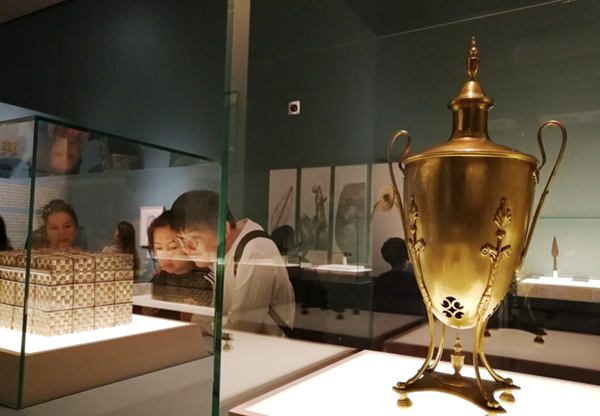
Visitors watch cultural relics from Russia at the exhibition. (Photo/People’s Daily Online)
The exhibition is divided into two sections: the land Silk Road and maritime Silk Road, introducing cultural relics from 13 countries including China, Cambodia, Japan, Kazakhstan, Latvia, Mongolia, Oman, Poland, Republic of Korea, Romania, Russia, Slovenia, and Tajikistan.
The relics include both national historic treasures and exotic items that carry the history of trade and cultural exchanges along the ancient Silk Road.
According to the exhibition, China started exchanges with the western Eurasia as early as in the prehistoric age. The artifacts of Turbino culture that originated from Russia are reliable evidences. They have been found multiple times in northwest China’s Gansu and Qianghai provinces as well as central China’s Henan province. The barbed spear of Turbino culture collected by the National Museum of China and the leaf-like spear sent from Russia resembled with each other.
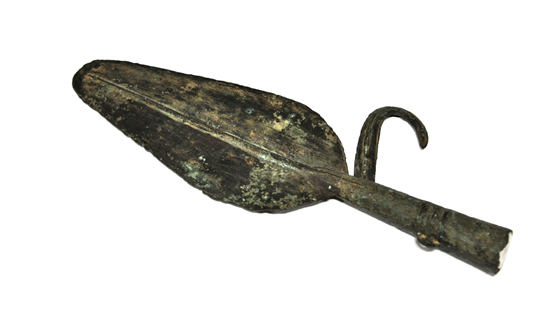
Photo shows a barbed spear, artifact of Turbino culture, collected by the National Museum of China. (Photo from the official website of the National Museum of China)
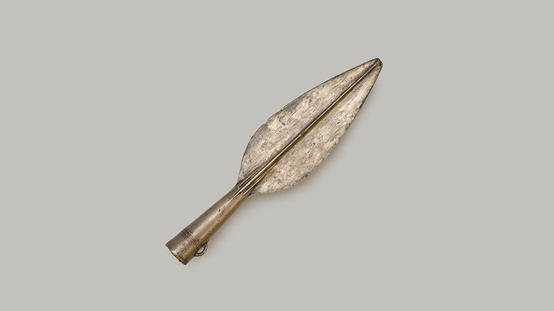
Photo shows a leaf-like spear sent from Russia at the exhibition. (Photo from the official website of the National Museum of China)
The eastern section of the Silk Road was unclogged by Emperor Wu of Western Han Dynasty (206 BC-9 AD) in the late 2nd century BC, and the channel was later joined by the Roman Empire from the western end.
During a long period of history, the Silk Road served as a relatively safe and effective channel for trade and cultural exchanges between the east and the west. Ever since, the communication and exchanges between the two parts of the world kept on.
A Chinese-style porcelain plate made by Iran now collected by the National Museum of Poland is a record of the trade and cultural exchanges along the Silk Road.
Such record can also be reflected by a Chinese cup manufactured in the Tang Dynasty (618-907) unearthed in Latvia which, according to experts, may have traveled all the way through Central Asia,Bulgaria, and Scandinavia through trade, and ended up onto the shore of the Baltic Sea.
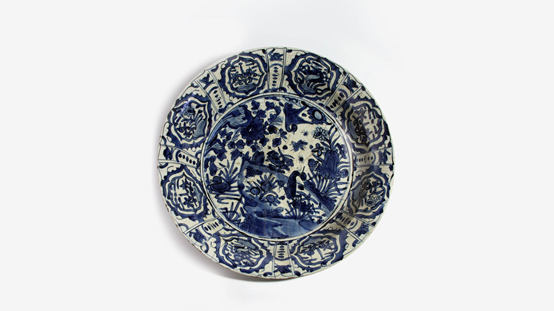
Photo shows an Iran-made Chinese-style porcelain plate collected by the National Museum of Poland. It is a record of the trade and cultural exchanges along the Silk Road. (Photo from the official website of the National Museum of China)
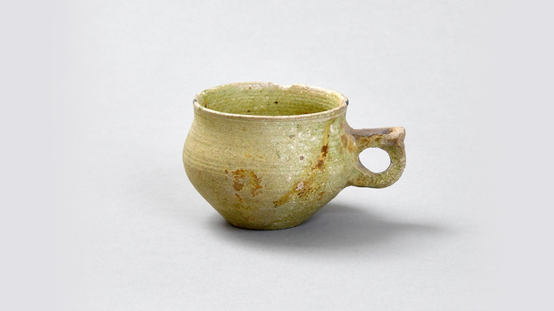
Photo shows the only Chinese cultural relic unearthed in Latvia – a single-handle cup made in Tang Dynasty (681-907) (Photo from the official website of the National Museum of China)
In 1913, Edouard Chavannes, a renowned French sinology, proposed the concept of maritime Silk Road for the first time. The maritime trade channel is also called maritime porcelain road and maritime spice road as porcelain and spice were the major goods traded along the route.
A plaque carved with the language of Hadhramaut collected by the National Museum of Oman recorded the booming frankincense trade of the kingdom of ?a?ramawt at that time.
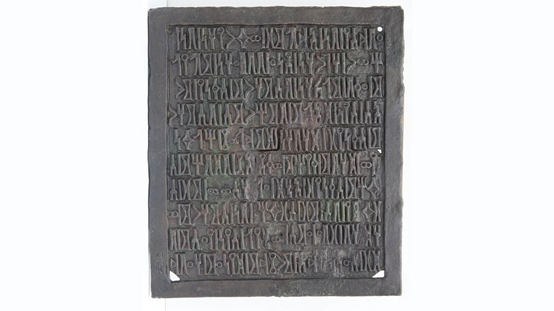
Photo shows a plaque carved with the language of Hadhramaut collected by the National Museum of Oman. (Photo from the official website of the National Museum of China)
The history of the Silk Road still has a profound influence even today, said the National Museum of Korea in the foreword of the exhibition.
All regions covered by the network could eliminate misunderstanding, live in harmony and achieve common prosperity through communication and cooperation, and the Silk Road is a core concept that helps the Republic of Korea, China and Japan, all situating at the eastern end of the Silk Road, understand the cultural traditions of each other, foreword of the exhibition.
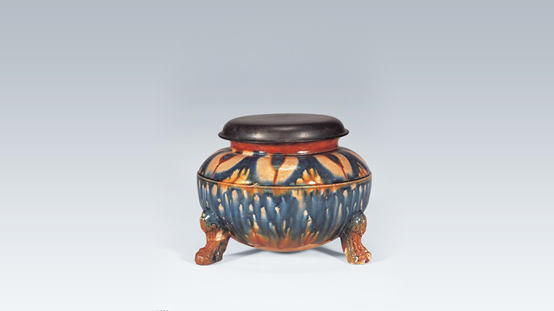
Photo shows a Tang tri-color glazed pottery collected by the National Museum of Korea. (Photo/chnmuseum.cn)
In Nov. 2018, the National Museum of China hosted the First Conference of the International Alliance of Museums of the Silk Road, and signed a cooperation agreement under the proposal of Chinese President Xi Jinping, said Wang.
The exhibition, as a concrete step to implement the agreement, will last until July 14, 2019, Wang added.
 Fire brigade in Shanghai holds group wedding
Fire brigade in Shanghai holds group wedding Tourists enjoy ice sculptures in Datan Town, north China
Tourists enjoy ice sculptures in Datan Town, north China Sunset scenery of Dayan Pagoda in Xi'an
Sunset scenery of Dayan Pagoda in Xi'an Tourists have fun at scenic spot in Nanlong Town, NW China
Tourists have fun at scenic spot in Nanlong Town, NW China Harbin attracts tourists by making best use of ice in winter
Harbin attracts tourists by making best use of ice in winter In pics: FIS Alpine Ski Women's World Cup Slalom
In pics: FIS Alpine Ski Women's World Cup Slalom Black-necked cranes rest at reservoir in Lhunzhub County, Lhasa
Black-necked cranes rest at reservoir in Lhunzhub County, Lhasa China's FAST telescope will be available to foreign scientists in April
China's FAST telescope will be available to foreign scientists in April "She power" plays indispensable role in poverty alleviation
"She power" plays indispensable role in poverty alleviation Top 10 world news events of People's Daily in 2020
Top 10 world news events of People's Daily in 2020 Top 10 China news events of People's Daily in 2020
Top 10 China news events of People's Daily in 2020 Top 10 media buzzwords of 2020
Top 10 media buzzwords of 2020 Year-ender:10 major tourism stories of 2020
Year-ender:10 major tourism stories of 2020 No interference in Venezuelan issues
No interference in Venezuelan issues
 Biz prepares for trade spat
Biz prepares for trade spat
 Broadcasting Continent
Broadcasting Continent Australia wins Chinese CEOs as US loses
Australia wins Chinese CEOs as US loses